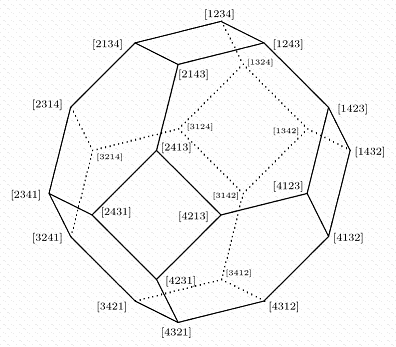From Gravity's Rainbow ((Penguin Classics paperback, June 1, 1995) —

From Gravity's Rainbow ((Penguin Classics paperback, June 1, 1995) —

On Friday, May 10, 2024, The Guardian reported the May 9 death
of rock drummer "Machine Gun" Thompson.
See as well a countdown requiem — May 10 News in this journal.
"The countdown as we know it, 10-9-8-u.s.w.,
was invented by Fritz Lang in 1929 for
the Ufa film Die Frau im Mond . He put it into
the launch scene to heighten the suspense.
'It is another of my damned "touches,"' Fritz Lang said."
Today's midday NY Lottery number was 753, the number of a significant page in Gravity's Rainbow .
An excerpt from that page ((Penguin Classics paperback, June 1, 1995)—

"… the Abyss had crept intolerably close, only an accident away…."
Midrash— See Ben Stein in this journal.
But seriously… See "Geometry and Death" in this journal.
See also PlanetMath.org on the Hesse configuration—

A picture of the Hesse configuration—
 .
.
Some context— A Study in Art Education.
Accidental Time and Space
New York Lottery today— midday 987, evening 522.
Time
The midday 987 may be interpreted as "…nine, eight, seven, …."—
"The countdown as we know it, 10-9-8-u.s.w.,
was invented by Fritz Lang in 1929 for
the Ufa film Die Frau im Mond . He put it into
the launch scene to heighten the suspense.
'It is another of my damned "touches,"' Fritz Lang said."
Space
The evening 522 suggests the date 5/22. From that date last year—
Art Space (2:02 AM EDT)
|
Pictorial version |
|
“Space: what you damn well have to see.”
– James Joyce, Ulysses
Today's midday lottery number in Pennsylvania
Related material from this journal—
Page 752 of Gravity's Rainbow
(Penguin Classics, 1995).
("With Pointsman it's only habit, retro-scientism:
a last look back at the door to Stockholm,
closing behind him forever.")
The conclusion of yesterday’s commentary on the May 30-31 Pennsylvania Lottery numbers:
Thomas Pynchon, Gravity’s Rainbow:
“The fear balloons again inside his brain. It will not be kept down with a simple Fuck You…. A smell, a forbidden room, at the bottom edge of his memory. He can’t see it, can’t make it out. Doesn’t want to. It is allied with the Worst Thing.
He knows what the smell has to be: though according to these papers it would have been too early for it, though he has never come across any of the stuff among the daytime coordinates of his life, still, down here, back here in the warm dark, among early shapes where the clocks and calendars don’t mean too much, he knows that’s what haunting him now will prove to be the smell of Imipolex G.
Then there’s this recent dream he is afraid of having again. He was in his old room, back home. A summer afternoon of lilacs and bees and
286”
What are we to make of this enigmatic 286? (No fair peeking at page 287.)
One possible meaning, given The Archivist‘s claim that “existence is infinitely cross-referenced”–
Page 286 of Ernest G. Schachtel, Metamorphosis: On the Conflict of Human Development and the Psychology of Creativity (first published in 1959), Hillsdale NJ and London, The Analytic Press, 2001 (chapter– “On Memory and Childhood Amnesia”):
“Both Freud and Proust speak of the autobiographical [my italics] memory, and it is only with regard to this memory that the striking phenomenon of childhood amnesia and the less obvious difficulty of recovering any past experience may be observed.”
The concluding “summer afternoon of lilacs and bees” suggests that 286 may also be a chance allusion to the golden afternoon of Disney’s Alice in Wonderland. (Cf. St. Sarah’s Day, 2008)
Some may find the Disney afternoon charming; others may see it as yet another of Paul Simon’s dreaded cartoon graveyards.
More tastefully, there is poem 286 in the 1919 Oxford Book of English Verse– “Love.”
For a midrash on this poem, see Simone Weil, who became acquainted with the poem by chance:
“I always prefer saying chance rather than Providence.”
— Simone Weil, letter of about May 15, 1942
Weil’s brother André might prefer Providence (source of the Bulletin of the American Mathematical Society.)
 (Photo from Providence)
(Photo from Providence)

For more on the mathematical significance of this figure, see (for instance) Happy Birthday, Hassler Whitney, and Combinatorics of Coxeter Groups, by Anders Björner and Francesco Brenti, Graduate Texts in Mathematics, vol. 231, Springer, New York, 2005.
This book is reviewed in the current issue (July 2008) of the above-mentioned Providence Bulletin.
The review in the Bulletin discusses reflection groups in continuous spaces.
Powered by WordPress